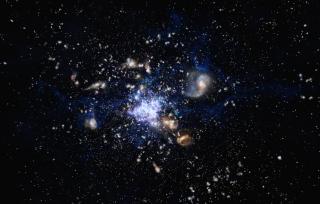Zhang, Y. H.; Dannerbauer, H.; Pérez-Martínez, J. M.; Koyama, Y.; Zheng, X. Z.; D'Eugenio, C.; Emonts, B. H. C.; Calvi, R.; Chen, Z.; Daikuhara, K.; De Breuck, C.; Jin, S.; Kodama, T.; Lehnert, M. D.; Naufal, A.; Shimakawa, R.
Referencia bibliográfica
Astronomy and Astrophysics
Fecha de publicación:
12
2024
Revista
Número de citas
6
Número de citas referidas
5
Descripción
We report the results of the deep and wide Atacama Large Millimeter/submillimeter Array (ALMA) 1.2 mm mapping of the Spiderweb protocluster at z = 2.16. The observations were divided into six contiguous fields covering a survey area of 19.3 arcmin2. With ∼13h of on-source time, the final maps in the six fields reach the 1σ rms noise in a range of 40.3 ‑ 57.1 μJy at a spatial resolution of 0″.5 ‑ 0″.9. By using different source extraction codes and careful visual inspection, we detected 47 ALMA sources at a significance higher than 4σ. We constructed the differential and cumulative number counts down to ∼0.2 mJy after the correction for purity and completeness obtained from Monte Carlo simulations. The ALMA 1.2 mm number counts of dusty star-forming galaxies (DSFGs) in the Spiderweb protocluster are overall two times that of general fields, with some regions showing even higher overdensities (more than a factor of three). This is consistent with the results from previous studies over a larger scale using single-dish instruments. Comparison of the spatial distributions between different populations indicates that our ALMA sources are likely drawn from the same distribution as CO(1–0) emitters from the COALAS large program but are distinct from that of Hα emitters. The cosmic star formation rate density of the ALMA sources is consistent with previous results (e.g., LABOCA 870 μm observations) after accounting for the difference in volume. We show that molecular gas masses estimates from dust measurements are not consistent with the ones derived from CO(1–0) and thus have to be taken with caution. The multiplicity fraction of single-dish DSFGs is higher than that of the field. Moreover, two extreme concentrations of ALMA sources were found on the outskirts of the Spiderweb protocluster, with an excess of more than 12 times that of the general fields. These results indicate that the ALMA-detected DSFGs are supplied through gas accretion along filaments and are triggered by intense star formation by accretion shocks before falling into the cluster center. The identified two galaxy groups are likely falling into the protocluster center and will trigger new merger events eventually, as indicated in simulations.
Proyectos relacionados

Gas Molecular y Polvo en Galacias através del Tiempo Cósmico
Dos cuestiones fundamentales en la Astrofísica son la conversión de gas molecuar en estrellas y cómo este proceso físico depende del entorno en todas las escalas, desde sistemas planetarios, cúmulos estelares, galaxias hasta cúmulos de galaxias. El objectivo principal de este proyecto es el de estudiar la formación y evolución de galaxias a partir
Helmut
Dannerbauer